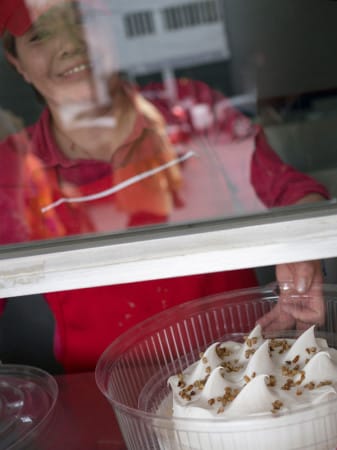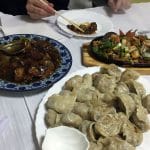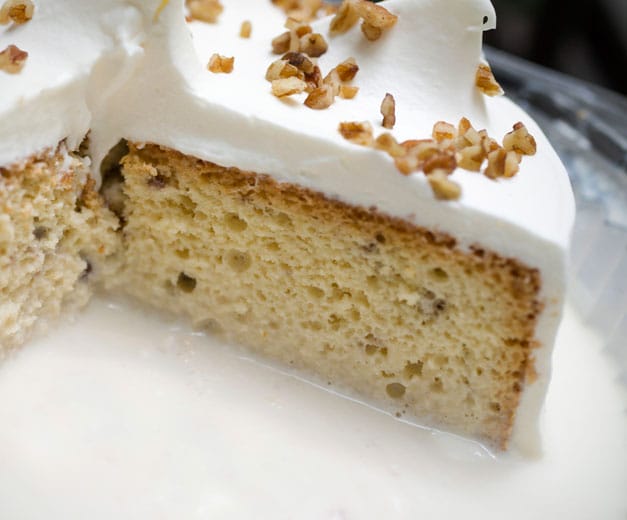Pastel de tres leches is beloved throughout much of Latin America, and yet its origins remain a mystery. Some people claim that it was first baked in Nicaragua, others that the recipe was first printed on the label of a well-known brand of canned condensed milk in Mexico.
Tres leches is usually a sponge cake soaked – as you might have guessed from the name – in a mixture of condensed, evaporated and regular milk, which might be flavored with vanilla, rum and cinnamon. The cake is baked and soaked in the milk mixture while it’s still warm and in the pan. It sits overnight so that the milk and flavorings thoroughly saturate every bite.

Similar cakes – soaked in alcohol and/or custard – came to Mexico from Europe before the 20th century, and these include rum cake, trifle, fruitcake or Italian zuppa inglese and tiramisu. Perhaps the likeliest explanation for how tres leches came to be is that it was an adaptation of one or more of these.
In Mexico City, every bakery offers at least one version of this cake for weddings, baptisms, quinceaños (the traditional party thrown for girls when they turn 15 years old), birthdays and pretty much any other kind of celebration.
Pastelería La Ideal, located downtown and one of our favorite bakeries in the city, maintains a spacious showroom on the second floor that displays all the cakes they can make, and tres leches is one of the many possibilities.
 Another one of our favorite pastelerías specializes in different types of tres leches cakes. As if the rich milk combination wasn’t enough, Pastelería La Universal offers versions that include cajeta, caramelized goat’s milk, and rompope, a kind of alcoholic eggnog. They make some of the best tres leches cakes we’ve ever had.
Another one of our favorite pastelerías specializes in different types of tres leches cakes. As if the rich milk combination wasn’t enough, Pastelería La Universal offers versions that include cajeta, caramelized goat’s milk, and rompope, a kind of alcoholic eggnog. They make some of the best tres leches cakes we’ve ever had.
In Mexico City, you don’t have to wait for a special celebration to enjoy tres leches; it’s available by the slice at many markets, coffee shops and restaurants. Better yet, you can get tres leches cake in a cup from Macram, a bakery with locations all over Mexico City that has been devoted for several decades to making just this treat. Besides the original, they make chocolate, rompope, coffee and almond flavors too.
 October 8, 2018 In Full Bloom
October 8, 2018 In Full Bloom
For Josué Barona, the Mercado San Juan has always been part of his life: his mother and […] Posted in Mexico City November 19, 2018 Clandestine No More
November 19, 2018 Clandestine No More
Most European capital cities have a Chinatown, and Lisbon is no different. In the 1980s […] Posted in Lisbon August 4, 2021 Kadıköy Kelle Söğüş Muammer
August 4, 2021 Kadıköy Kelle Söğüş Muammer
Before we cross the Bosphorus Strait to Asia, this story starts on Istanbul’s European […] Posted in Istanbul
Published on March 24, 2014
Related stories
Learn more about the important role the market plays in daily Mexico City life on our walk!
October 8, 2018
Mexico City | By Susannah Rigg
Mexico CityFor Josué Barona, the Mercado San Juan has always been part of his life: his mother and father both have stalls there, just around the corner from each other, and he has been working among the bustling food stands from a young age. While the stand that the now 35-year-old works at doesn’t really have…
November 19, 2018
LisbonMost European capital cities have a Chinatown, and Lisbon is no different. In the 1980s many immigrants from the Zhejiang province, on China’s eastern coast, made downtown Mouraria their home; the wave of newcomers remained steady and eventually peaked in the 2000s. As the first generation grows up, their family businesses are leaving indelible marks…
August 4, 2021
IstanbulBefore we cross the Bosphorus Strait to Asia, this story starts on Istanbul’s European side, at a small stand that has been operating in Beyoğlu since the mid-1970s. There, Muammer usta serves up expertly-cooked and sliced cuts of kelle söğüş (chilled lamb's head meat), perched in a strategic location across from the local fish market…


















































































